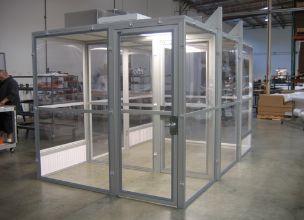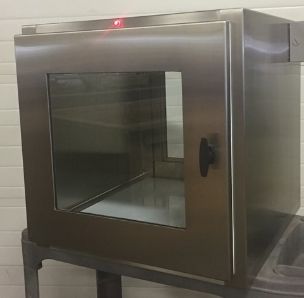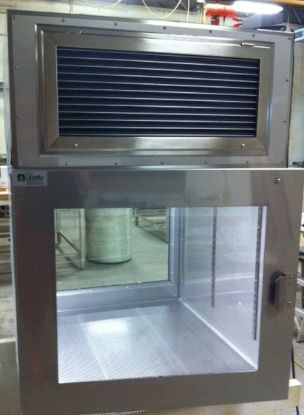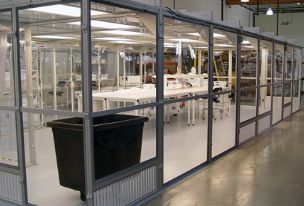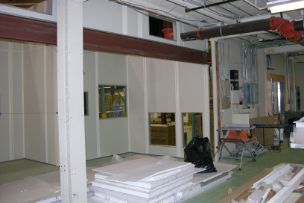Within cleanroom operations, there is often the need to exchange products among personnel inside and outside the cleanroom environment. However, the risk of contamination increases drastically when people continuously enter and leave a cleanroom area. In these situations, a cleanroom pass thru offers the ideal solution, allowing for the safe transfer of equipment and materials without exposing the cleanroom to hazardous contaminants.
What is a Cleanroom Pass Thru?
A cleanroom pass thru is a chamber that facilitates the passing of materials into and out of a cleanroom without employees having to exit and change gowns. By decreasing the number of times an operator has to leave and reenter the cleanroom, cleanroom pass thrus significantly minimize contamination risks.
Cleanroom Pass Thrus are Also Often Called:
- Pass Through Boxes
- Pass-Through Chambers
- Cleanroom Pass Thru Windows
- Pass-Through Cabinets
Applications and Benefits of Cleanroom Pass Thrus
A cleanroom pass thru helps to eliminate the risk of contamination, allowing manufacturers to adhere to industry quality standards. Several industries that commonly utilize pass thrus include:
Medical
Pharmaceutical
Food Processing
Aerospace
Computers
Consumer Electronics
Key Benefits of Using a Cleanroom Pass Thru Include:
- Reducing Gowning Costs: Reducing the number of personnel entering the cleanroom environment cuts down on costs associated with laundering and purchasing sterile gowns, shoe coverings, coveralls, and other apparel. A cleanroom pass thru can also save time and money by preventing production delays commonly encountered by gowning procedures.
- Meeting Fire Code: Cleanroom pass thrus can be constructed with fire-rated doors. These doors often consist of insulated double-wall stainless steel, fire-rated glass windows, and other safety features that ensure they adhere to strict fire regulations.
- Maintaining Stable Pressure Differentials: The use of personnel doors can compromise the required positive or negative pressure balance in a cleanroom environment. Using a cleanroom pass thru eliminates the need for installing airlocks or other complex air filtration systems, significantly reducing associated expenses.
- Inventory Management: Multi-chamber pass thru windows allow for quick and easy transfer of high-volume inventory without requiring personnel to be on both sides of the box during the stocking process. These pass thrus can be equipped with bar code scanners to conveniently track all products entering and exiting the cleanroom. Temperature and humidity controls help to preserve environmentally sensitive components.
- Personnel Safety: Cleanroom pass thrus reduce the amount of personnel that need to enter the containment area, drastically reducing contamination caused by foot traffic. The pass thrus also protect against exposure to potentially hazardous biological agents and chemicals. This makes them a great option for chemical processing laboratories and pharmaceutical applications.
- Parts Conditioning: Pass thrus can be used as conditioning chambers to store products in a controlled setting or treat the contents during the transfer process. Depending on your needs, conditioning pass thrus can come with additional accessories such as air shower washes, refrigeration modules, and UV-C disinfection units to kill viruses, mold spores, and bacteria.
- Neutralizing Static Charges: Pass thrus can come with ionizing modules to neutralize static charges and reduce damage to static-sensitive products. Pass thru chambers constructed using static-dissipative materials eliminate the potential risk of electrostatic discharge and surface attraction, making the units easier to clean.
- Security: Pass thrus improve security by limiting access to controlled substances or spaces. This makes them ideal for high-security applications such as pharmaceuticals or correctional facilities.

How Cleanroom Pass Thrus Work
Cleanroom pass thru doors feature interlocks that prevent both doors from being open simultaneously, eliminating the risk of cleanroom depressurization. Transferring materials into a cleanroom starts when someone opens the pass thru door on the “dirty air” side. The interlock mechanism then manually or automatically locks the door on the cleanroom side.
Using a Cleanroom Pass Thru Involves These Steps:
Step One. On the dirty air side, the operator places the material into the pass thru and closes and latches the door. The pass thru has sturdy, latching doors on both sides that tightly compress against non-absorbent or closed-cell gaskets to prevent cleanroom air loss. If cleanroom air pressure drops, untreated dirty air will enter the cleanroom at a lower pressure.
Step Two. When the interlocking mechanism releases, the operator can open the door on the cleanroom side and transfer the materials into the cleanroom.
Step Three. The operator closes the cleanroom side door once the transfer is complete. Once both doors are shut, the interlock releases, and the pass thru is ready to be used again.
Choosing the Right Clean Room Pass Thru
The interlock mechanism and doors are the primary components of a cleanroom pass thru. While they are the most critical parts, they are also the most common to malfunction or break. In a worst-case scenario, an out-of-service or non-functioning pass thru window can result in costly shutdowns of vital operations. Cleanroom pass thrus all have similar features and design standards, and they are typically manufactured in three levels:
Choosing the Right Clean Room Pass Thru
The interlock mechanism and doors are the primary components of a cleanroom pass thru. While they are the most critical parts, they are also the most common to malfunction or break. In a worst-case scenario, an out-of-service or non-functioning pass thru window can result in costly shutdowns of vital operations. Cleanroom pass thrus all have similar features and design standards, and they are typically manufactured in three levels:
-
Basic Stainless Steel Pass Thru Chambers
This type of pass thru chamber is easy to wipe down, making it suitable for almost every need, including semiconductor and pharmaceutical manufacturing. The chamber floor is completely flush, with no lip in the front to clean around. They also typically feature durable, heavy-gauge hard-edge door gaskets to eliminate crevices that could otherwise harbor contamination.
Stainless steel pass thru chambers consist of a welded stainless steel shell and double-wall construction to hide and protect the built-in mechanical interlock and turn latch. Primary benefits of this type of cleanroom pass thru include:
- Lipless, flush floor for easy cleaning and material transfer
- Extremely strong and durable
- Superior aesthetics for pharmacies and cleanrooms
-
Full Welded Body
This type of pass thru cabinet features fully welded stainless steel interiors and smooth, formed radius corners to make spills easily wipeable and prevent contaminants from collecting in the corners. This makes full welded body pass thrus ideal for chemo drug pharmacies, compounding pharmacies, aseptic manufacturing, and other applications that require sterility and easy cleaning.
-
Bio-Design
Bio-contaminant, germ-free processes typically require aseptic cleaning of all equipment surfaces in a cleanroom environment. Bio-design pass thrus consists of a sturdy, fully welded body with a seamless interior, coved radius, and knife-edge hatch openings. Bio-design pass thru chambers are ideal for nanotechnology and production facilities, terminal sterilization processing, and other ultra-hygienic applications. Typically constructed with medical-grade stainless steel materials to meet stringent industry standards, bio-design pass thrus are commonly found in:
- Hospitals
- Operating rooms
- Procedural rooms
- Surgical suites
Customization Options
Cleanroom pass thrus can be customized with various features, including:
-
- Wall Mounted Pass-Thrus. These are designed for cleanroom environments with space limitations. Depending on your needs, they can be designed with a 90° turn in the pass thru, and they feature stainless steel integrity, a double wall design, and facilitate easy cleaning.
- Fire Rated Windows & Doors. These provide an enclosed airlock space between the cleanroom and adjoining area, preventing unwanted particles from entering the cleanroom. Fire-rated pass thru units offer easy operation and provide cleanroom protection with additional fire safeguard advantages.
- Magnetic Interlocks. Magnetic interlocking mechanisms prevent both doors from being opened simultaneously. At Liberty Industries, our H-100SS pass thru with magnetic interlocks is ideal for hospital pharmacies and other settings where quality and security are imperative.
- HEPA/ULPA Filters. Our Class 100 (ISO 5) pass thru module has a high-velocity air wash of 100 FPM through a HEPA filter. These filters are 99.99% efficient on particles that are 0.3 microns or bigger. The HEPA filter remains in continuous operation, so every time a door is opened, the air has already been filtrated through multiple cycles, effectively removing airborne contamination.
- Lamination. Pass thrus can be custom-constructed with novaply laminated plastic. This allows for easier access for transferring materials between dirtier areas and the cleanroom while ensuring optimal protection against outer contamination.
- Automatic Motorized Doors. For applications where standard swing doors or manual operation is not ideal, pass thrus can be constructed with automatic sliding vertical doors. This option is ideal for use in laboratories or manufacturing with continuous flow operations.
Learn More About Cleanroom Pass Thrus
Liberty Industries is a distributor and manufacturer of high-quality cleanroom and contamination control supplies and accessories. Since 1953, we have been an industry leader in providing a wide range of products for solving critical environmental needs.
Contact us to learn more about our cleanroom pass thru products and services, or request information to see how Liberty Industries can meet the demands of your specific application.

